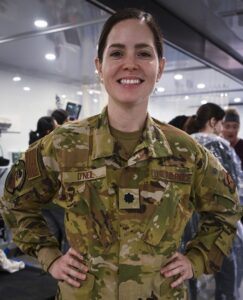
Story by Staff Sgt. Shelby Pruitt-Johnson
3d Audiovisual Squadron
JOINT BASE SAN ANTONIO, Texas – More than 40 U.S. Airmen and Air National Guardsmen participated in Operation Vapor Trails, a recurring medical readiness exercise centered on aeromedical evacuation, March 28, 2025.
This iteration was made possible by the coordination—and family bond—between U.S. Air Force Lt. Col. Erika O’Neil, a Critical Care Air Transport Team member with the 959th Medical Group at JBSA-Fort Sam Houston, and her brother, U.S. Air National Guard Maj. Patrick O’Neil, Director of Operations for the 137th Airlift Squadron at Stewart Air National Guard Base, N.Y.
The two siblings played pivotal roles in the mission, which is designed to sharpen response times, strengthen interagency coordination and test the Air Force’s ability to deliver lifesaving care under pressure.
“I flew on my first Vapor Trails mission as part of a Critical Care Air Transport Team (CCATT) about three years ago,” said Erika. “Immediately afterward, I called my brother to tell him how cool it was—and asked if it was something he and his crew would ever want to do.”
After years of talking about it, their schedules finally aligned. Erika had returned from deployment, and Patrick’s unit was available to support.
The 137th AS, part of the 105th Airlift Wing, operates the C-17 Globemaster III in missions across the globe. With its large cargo hold and ability to operate from short, austere runways, the C-17 is ideally suited for rapid deployment, aeromedical evacuation and in-flight critical care.
“It’s not uncommon for us to fly on C-17s, and it’s not uncommon for crews like his to support aeromedical evacuation rotations,” Erika explained. “That’s why getting reps like this—training side by side—is so valuable. CCATT teams and C-17 crews often fly together, so it’s important we understand each other’s roles and operate as one team.”
Exactly two years apart in age, Erika and Patrick grew up in an Air Force family and attended Reserve Officers’ Training Corps (ROTC) together at Florida State University.
“From there, I went to medical school and he went to pilot training,” Erika said. Little did they know their paths would one day cross in uniform—working side by side on a mission focused on rapid, coordinated emergency response, seamless communication and effective disaster relief.
This year’s Operation Vapor Trails was conducted in partnership with Texas emergency response agencies and in conjunction with Texas A&M’s Disaster Day, an annual student-led emergency response simulation.
The exercise began at JBSA-Kelly Field, where Airmen from the 59th Medical Wing and the 139th Aeromedical Evacuation Squadron loaded medical equipment onto a C-17 operated by the 105th Airlift Wing. Upon arrival at Texas A&M’s Disaster City, flight crews practiced tactical landings while medical personnel integrated with students to assess, stabilize and triage simulated patients.
Once stabilized, patients were loaded onto the aircraft, where CCATT and AE teams administered simulated medications, performed critical interventions and provided in-flight monitoring. Upon return to JBSA, patients were transferred to awaiting ground teams, completing the full mission cycle.
The hands-on scenario mirrored real-world joint operations—where rapid communication and coordination can mean the difference between life and death. Instructors and observers provided real-time feedback and ensured procedures were followed, maintaining a high-quality training environment.
“We’re just really lucky they were able to support—and that both our teams got such valuable training,” Erika said. “My favorite part of the day was, honestly, that my crew got to meet my baby brother. It’s kinda cool to be an Air Force family and work together.”